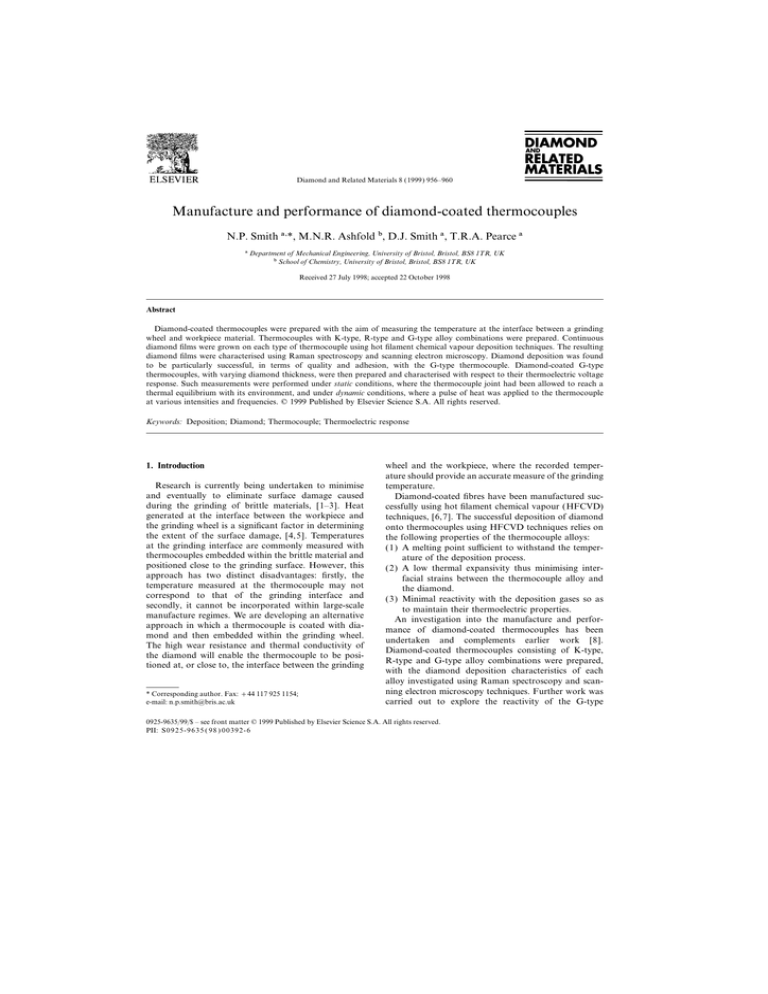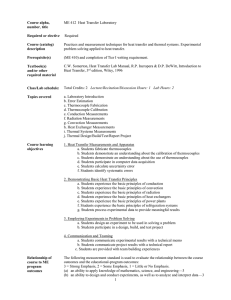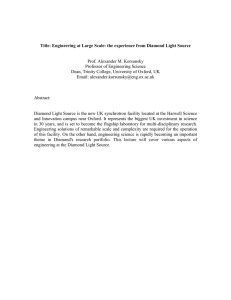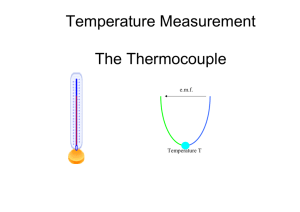
Diamond and Related Materials 8 (1999) 956–960
Manufacture and performance of diamond-coated thermocouples
N.P. Smith a,*, M.N.R. Ashfold b, D.J. Smith a, T.R.A. Pearce a
a Department of Mechanical Engineering, University of Bristol, Bristol, BS8 1TR, UK
b School of Chemistry, University of Bristol, Bristol, BS8 1TR, UK
Received 27 July 1998; accepted 22 October 1998
Abstract
Diamond-coated thermocouples were prepared with the aim of measuring the temperature at the interface between a grinding
wheel and workpiece material. Thermocouples with K-type, R-type and G-type alloy combinations were prepared. Continuous
diamond films were grown on each type of thermocouple using hot filament chemical vapour deposition techniques. The resulting
diamond films were characterised using Raman spectroscopy and scanning electron microscopy. Diamond deposition was found
to be particularly successful, in terms of quality and adhesion, with the G-type thermocouple. Diamond-coated G-type
thermocouples, with varying diamond thickness, were then prepared and characterised with respect to their thermoelectric voltage
response. Such measurements were performed under static conditions, where the thermocouple joint had been allowed to reach a
thermal equilibrium with its environment, and under dynamic conditions, where a pulse of heat was applied to the thermocouple
at various intensities and frequencies. © 1999 Published by Elsevier Science S.A. All rights reserved.
Keywords: Deposition; Diamond; Thermocouple; Thermoelectric response
1. Introduction
Research is currently being undertaken to minimise
and eventually to eliminate surface damage caused
during the grinding of brittle materials, [1–3]. Heat
generated at the interface between the workpiece and
the grinding wheel is a significant factor in determining
the extent of the surface damage, [4,5]. Temperatures
at the grinding interface are commonly measured with
thermocouples embedded within the brittle material and
positioned close to the grinding surface. However, this
approach has two distinct disadvantages: firstly, the
temperature measured at the thermocouple may not
correspond to that of the grinding interface and
secondly, it cannot be incorporated within large-scale
manufacture regimes. We are developing an alternative
approach in which a thermocouple is coated with diamond and then embedded within the grinding wheel.
The high wear resistance and thermal conductivity of
the diamond will enable the thermocouple to be positioned at, or close to, the interface between the grinding
* Corresponding author. Fax: +44 117 925 1154;
e-mail: n.p.smith@bris.ac.uk
wheel and the workpiece, where the recorded temperature should provide an accurate measure of the grinding
temperature.
Diamond-coated fibres have been manufactured successfully using hot filament chemical vapour (HFCVD)
techniques, [6,7]. The successful deposition of diamond
onto thermocouples using HFCVD techniques relies on
the following properties of the thermocouple alloys:
(1) A melting point sufficient to withstand the temperature of the deposition process.
(2) A low thermal expansivity thus minimising interfacial strains between the thermocouple alloy and
the diamond.
(3) Minimal reactivity with the deposition gases so as
to maintain their thermoelectric properties.
An investigation into the manufacture and performance of diamond-coated thermocouples has been
undertaken and complements earlier work [8].
Diamond-coated thermocouples consisting of K-type,
R-type and G-type alloy combinations were prepared,
with the diamond deposition characteristics of each
alloy investigated using Raman spectroscopy and scanning electron microscopy techniques. Further work was
carried out to explore the reactivity of the G-type
0925-9635/99/$ – see front matter © 1999 Published by Elsevier Science S.A. All rights reserved.
PII: S0 9 2 5- 9 6 3 5 ( 9 8 ) 0 0 39 2 - 6
N.P. Smith et al. / Diamond and Related Materials 8 (1999) 956–960
thermocouple alloy with the deposition gases. Finally
the thermoelectric properties of the diamond-coated
G-type thermocouple alloy were measured in a static
thermal environment, where the thermocouple is
allowed to reach thermal equilibrium with its environment, and in dynamic thermal environments where the
frequency response of the thermocouple was
characterised.
957
2. Experiments and results
2.1. Diamond-coated thermocouple fabrication and
characterisation
Thermocouples with K-type (Ni Cr –Ni Mn 90 10
95
2
Al Si ), R-type (Pt Rh –Pt) and G-type ( W Re –
2 1
87 13
74 26
W ) alloy combinations were prepared using 125 mm
Fig. 1. (a) Fracture surface of R-type diamond-coated thermocouples showing debonding between the wire core and diamond coat. (b) Fracture
surface of G-type diamond-coated thermocouple showing no debonding between the wire core and the diamond coat.
958
N.P. Smith et al. / Diamond and Related Materials 8 (1999) 956–960
diameter wires. The wires of each thermocouple alloy
combination were twisted and spot welded at an appropriate voltage to form a bead.
Diamond was deposited onto the thermocouples using
HFCVD techniques, using a 0.85% methane–hydrogen
gas mixture at 30 Torr (4 kPa), [6 ]. The temperature of
the heating filament was maintained at 2200 °C, as
measured with an infrared pyrometer. Radiation from
this heated the thermocouples to approximately 900 °C.
Deposition times for the K-type and R-type thermocouples was 30 h at a rate of 1.5 mm h−1. Diamond deposition times for G-type thermocouples were varied
providing diamond coating thicknesses of 20, 40, 60
and 140 mm.
To examine the coatings on each of the thermocouples,
the fibres were fractured and their cross-sections examined under a scanning electron microscope at the appropriate magnification. Fig. 1 shows typical cross-sections
for the diamond-coated R and G-type thermocouples.
The image of the R-type thermocouple fibre shows that
there is poor adhesion between the diamond coat and
the wire core. In contrast, the coated G-type thermocouple appears to have good structural integrity with no
evidence for debonding of the diamond from the metal
core and no cracking of the diamond coat observed.
This suggests that residual stresses produced during the
HFCVD of diamond are not significant for this metal
alloy and is consistent with previous reports of successful
HFCVD of diamond on tungsten cores, [6 ]. Similar
images of the K-type thermocouple fibres show that the
coating is brittle and delaminates easily. Raman analysis
shows that the coating to be non-diamond carbon.
The deposition of diamond and other carbon phases
was investigated for each diamond-coated thermocouple
alloy combination using Raman spectroscopy. The
Raman spectrum analyser used an argon ion laser with
a wavelength of 488 nm and a power output of 3 mW.
Raman spectra between 800 and 1800 cm−1 were
recorded. Fig. 2 shows the Raman spectra obtained
from the K-type, R-type and G-type thermocouples
after HFCVD. The intense 1332 cm−1 feature confirms
that diamond deposition has been successful for both
R-type and G-type thermocouples; the presence of a
small amount of amorphous carbon is also indicated by
the deviation in the Raman response from the background between 1400 and 1600 cm−1. Diamond deposition for the K-type thermocouple was unsuccessful; the
two broad features at 1355 and 1580 cm−1 are indicative
of graphitic carbon.
Diamond growth on tungsten, the main element of a
G-type thermocouple, was investigated further by Auger
electron analysis. Tungsten-cored diamond fibres which
had different coating thicknesses, as a result of different
deposition times, were fractured in air before being
loaded into a scanning Auger microprobe analyser. Prior
to analysis each fracture surface was sputter cleaned, at
Fig. 2. Raman spectra of K-type, R-type and G-type thermocouples
after removal from the HFCVD reactor.
a pressure of 10−10 Torr to ensure freedom from contamination. Auger analysis was carried out at a working
potential of 10 keV, using a beam a current of
3×107 A with a spot diameter of 0.5 mm. Auger spectra
were generated between 30–600 eV. The results of the
Auger analysis are shown in Fig. 3. The extent of
carburisation of the tungsten core was assessed by
calculating the ratio of the Auger electron intensity for
tungsten carbide at 286 eV, I , to that for tungsten at
wc
180 eV, I . The ratio I /I is plotted from the centre
w
wc w
of the fibres’ cores to the diamond–thermocouple interface. Fig. 3 clearly shows that the formation of tungsten
carbide is limited to the interface between the tungsten
wire and diamond coating. The tungsten carbide interfacial layer forms during early stages of diamond growth
but its development is slowed with increasing diamond
growth until it reaches a constant thickness.
2.2. Thermoelectric response of G-type diamond-coated
thermocouples
The static thermoelectric responses of G-type thermocouples with diamond coatings between 0 and 60 mm
were measured in a box furnace. Thermocouples were
heated at 10 °C min−1 to a maximum temperature of
600 °C. The thermoelectric response of each thermocouple plotted against that of a K-type thermocouple positioned adjacent is shown in Fig. 4. The thermoelectric
responses of the thermocouples are similar below 150 °C
and above 450 °C. However, between these two temper-
N.P. Smith et al. / Diamond and Related Materials 8 (1999) 956–960
Fig. 3. Plot showing the ratio I /I , deduced from Auger analysis
wc w
across fracture surfaces of tungsten cored diamond-coated fibres produced using different deposition times.
959
Fig. 5. The dynamic thermoelectric response of an uncoated and 40 mm
thick diamond-coated G-type thermocouple with a heating rate of
650 °C s−1.
The dynamic thermoelectric response of G-type thermocouples was investigated using a rapid thermal
annealer with an argon atmosphere. The thermoelectric
responses of an uncoated G-type thermocouple and a
40 mm diamond-coated G-type thermocouple were
amplified with a half-bridge amplifier before being digitised at a 7 Hz frequency. The thermocouples were
heated at 650 °C s−1 and the thermoelectric responses
measured as a function of time. The results of this
investigation, which are shown in Fig. 5, suggest that
the frequency response of the thermocouple is not
affected by the diamond coat.
3. Concluding remarks
Fig. 4. The thermoelectric response of bare and diamond-coated
G-type thermocouples as a function of diamond thickness measured
in a static thermal environment.
atures the difference between the thermoelectric response
of the coated and uncoated thermocouples varies by as
much as 0.6 mV corresponding to a temperature of
100 °C. The reason for this disparity is not clear and
will be investigated further in forthcoming work.
Diamond-coated thermocouples have been successfully prepared for R-type and G-type thermocouple
combinations. The diamond-coated G-type thermocouples exhibited good structural integrity. Debonding
between the diamond coat and the thermocouple wire
is evident for R-type diamond-coated thermocouples.
The reactivity of the G-type thermocouple combination to the HFCVD deposition gases was low. A tungsten carbide layer was formed by the HFCVD process
but is shown to be restricted to regions close to the
interface between the thermocouple wire and the diamond coating.
960
N.P. Smith et al. / Diamond and Related Materials 8 (1999) 956–960
The thermoelectric responses of diamond-coated
G-type thermocouples are shown to be unaffected by
the diamond coating and independent of diamond thickness when measured in both static and dynamic thermal
environments.
Acknowledgements
Financial support for this study is supplied by a
EPSRC grant number GR/K91460. We would also like
to thank Steven Arscott and The Department of
Electronic and Electrical Engineering of the University
of Leeds for making available their rapid thermal
annealer and G. Scott, K.N. Rosser and M. Holt for
their help with this program of work.
References
[1] T.G. Bifano, T.A. Dow, R.O. Scattergood, Trans. ASME, J. Eng.
Ind. 13 (1991) 184.
[2] P.G. Partridge, A.J. Fookes, E.D. Nicholson, T. Pearce, G.
Meaden, J. Mater. Sci. 31 (1996) 5051.
[3] Jeong-Dukim, L. Eumsang, J. Mater. Process. Technol. 72
(1977) 1.
[4] W.B. Rowe, S. Black, B. Mills, H.S. Qu, Proc. R. Soc. London,
Ser. A 453 (1997) 1083.
[5] C. Guo, S. Malkin, Trans. ASME, J. Eng. Ind. 118 (1996) 143.
[6 ] P. May, C.A. Rego, M.N.R. Ashfold, K.N. Rosser, T.D. Walsh,
L. Holt, N.M. Everitt, P.G. Partridge, Diamond Relat. Mater. 4
(1995) 794.
[7] E. Kalaugher, N.M. Everitt, E.D. Nicholson, Diamond Relat.
Mater. 6 (1997) 826.
[8] P.G. Partridge, N.J. Williamson, C.J. Gilmore, C. Preece, Mater.
Sci. Technol. 14 (1998) 257.






